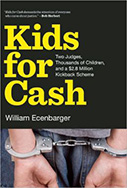Kids for Cash: Two Judges, Thousands of Children, and a $2.6 Million Kickback Scheme

Author: William Ecenbarger
Publisher: New York: The New Press, 2012. 272 p.
Reviewer: Kristin Henning | January 2014
“Martin Luther King warned us, ‘We will have to repent in this generation not merely for the hateful words and actions of the bad people, but for the appalling silence of the good people.’” (p. 88)
Between 2002-2008, Mark Ciavarella, former juvenile court judge in Luzerne County, Pennsylvania, sent hundreds of kids to jail in exchange for millions of dollars in kickbacks from a private juvenile detention facility. In Kids for Cash, William Ecenbarger explores the scandal in a compelling and accessible narrative that weaves together the details of the scandal with profiles of those involved, the historical context of Luzerne County with disturbing personal experiences of detained youths, and juvenile justice research with arguments for reform.
Due process in Ciavarella’s courtroom was a facade. Youth and their families were lured into waiving the youth’s right to counsel, with 54.8% of children waiving counsel in Luzerne as compared to 7.4% throughout the rest of Pennsylvania. Children in Luzerne were also two and a half times more likely to be sent to out-of-home placement than in other parts of the state. Ciavarella was cavalier and verbally abusive to youth and parents who appeared before him in hearings that routinely lasted less than five minutes. Despite dozens of witnesses to the practices in his courtroom, including prosecutors, defense attorneys, probation officers and law clerks, it took six years before Ciavarella was removed from the bench and prosecuted for his crimes.
After the so-called “kids-for-cash” scandal broke, the community and country were left dumbfounded and pressing for answers. What kind of person would be capable of callously incarcerating youth for kickbacks? How many people were involved? How was it able to go on for so long?
Ecenbarger helps us answer these questions. Rich in research on the historical and political context of northeastern Pennsylvania, his book explores the history of corruption reaching back to the nineteenth century, from the mining industry to the school board. With judges and legislators befriending mobsters and teachers having to pay up to $5,000 for employment, corruption was not a new phenomenon under Ciavarella’s reign, it was business as usual. Ecanbarger profiles Ciavarella, his family history, his financial woes, and his desire to maintain status and power in the community. The author’s exploration of Ciavarella’s past is fascinating, with the judge’s greed verging on sociopathic, even in the context of northeastern Pennsylvania.
During Ciarvella’s trial, mothers of his child-victims railed against prosecutors who focused on the monetary crimes of extortion and money-laundering and failed to mention the children traumatized by his crimes. No child-victims were called to testify and two jurors at the end of the case were still unaware of the kids-for-cash element of the scandal until they saw post-trial news coverage. As one mother described the trial, “Not only is this kids for cash, this is kids forgotten.” (p.217) Ecenberger’s book does what the prosecutors failed to do: it tells the children’s stories. His book is laced with emotionally compelling vignettes profiling the circumstances of the children’s arrests, their experiences in the courtroom and their traumatic and stigmatizing ordeals during incarceration. At times painful and dramatic, the vignettes create a compelling emotional connection between the reader and the victims as they illustrate the persistent and paralyzing trauma the scandal had on the youths and families involved.
Unfortunately, to emphasize his key theme — that incarcerating youth in the “kids for cash” scheme was devastating — Ecenbarger repeatedly juxtaposes the “good” kids victimized by the scandal with the “bad” kids awaiting them in juvenile detention. The author writes, “[a]t the camp, some of the girls were tough, inner-city teenagers convicted for violent crimes. But others were there for stealing their father’s credit card to buy clothes and for unintentionally bringing a pocketknife to school.” (p. 9) “No sinister gang inspired fifteen-year-old Paige to throw her sandal at her mother during an argument… she didn’t understand why she was interned with burglars, drug traffickers and prostitutes.” (pp. 99-100) Of course it is tempting to draw this good/bad distinction to augment the readers’ sympathy for the children harmed by the scandal. But this dichotomy has been a harmful and often racialized trope used to justify harsh and punitive responses to the supposed “bad” kids in the juvenile justice system. The author himself recognizes this problematic portrayal of youth in the system when he discusses the public’s apathy toward due process violations in Ciavarella’s court before the monetary corruption surfaced:
Some of the muted response [to the news of injustices in Ciavarella’s court in 2004] had to do with flawed public perceptions about juvenile justice in general and juvenile offenders in particular, with stories about youth gangs and “young predators” dominating the news out of juvenile court. In fact, only about 5 percent of juvenile arrests are for murder, rape, and other serious violent crimes. The overwhelming majority of young people’s offenses are property crimes, including vandalism, and drug and alcohol abuse. (pp. 75-76)
In light of that recognition, it is ironic that Ecenbarger plays into the very narrative he acknowledges as problematic.
Overall, however, the book is a riveting exposé on the need for juvenile justice reform couched in a tragic example of juvenile justice gone awry. Ecenbarger seamlessly incorporates arguments for reform and a plea for best practices by pointing to what did not work in Luzerne, and documenting what we do know works best with children. His book examines the psychology of adolescent development and offers a critique of zero-tolerance policies and the school-to-prison pipeline. The author considers evidence supporting community-based services and diversion as much more effective in reducing recidivism than incarceration, research illustrating the net-negative effects of incarcerating youth, fiscal arguments for reducing youth incarceration, arguments against shackling, and the importance of quality representation and due process protections for youth accused of crime. The petty crime for which youth were prosecuted in Luzerne is the same behavior for which thousands of youths across the country (and disproportionately youth of color) are prosecuted every day. By highlighting the perverse treatment of youth in the high-profile context of Luzerne, the author reveals what happens in American courtrooms every day when judges and prosecutors do not understand the link between adolescent development and delinquency and accused youth are denied the very basic procedural protections guaranteed by our Constitution.
Finally, Kids for Cash is a call to action. It was the “appalling silence of good people” that enabled Ciavarella’s scandal to succeed as long as it did. The public defender, the prosecutor, the clerks, the Judicial Conduct Board, probation officers, and teachers were all complicit in the Ciavarella’s crime. Routinely violating youths’ rights in his courtroom through illegal detention, illegal attorney waivers, illegal guilty pleas and insufficient fact-finding, Ciaveralla ran a kangaroo court. As Ecenbarger points out, people should have spoken up – long before the monetary kickbacks came to light. Ecenbarger calls upon every member of the justice system to be a watchdog and an advocate for justice. As Nelson Mandela said in 1963, “[n]othing in all the world is more dangerous than sincere ignorance and conscientious stupidity.”
Kristin Henning, Professor of Law, Georgetown Law


